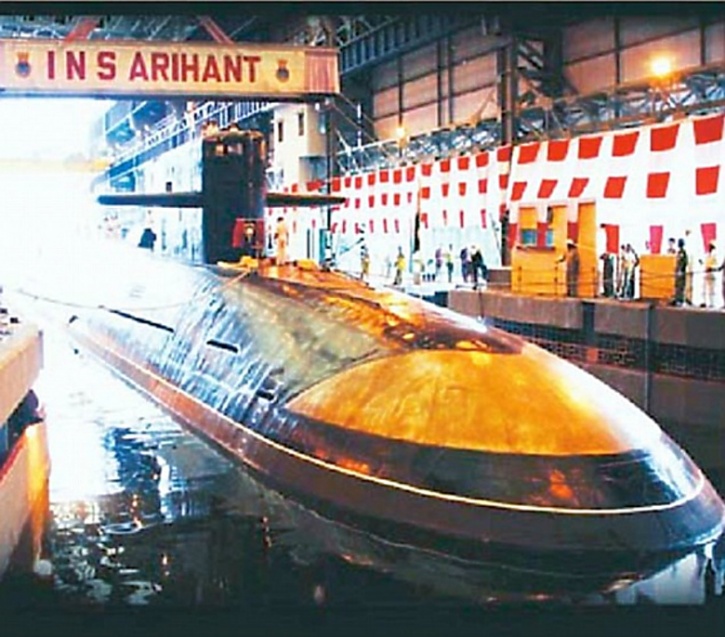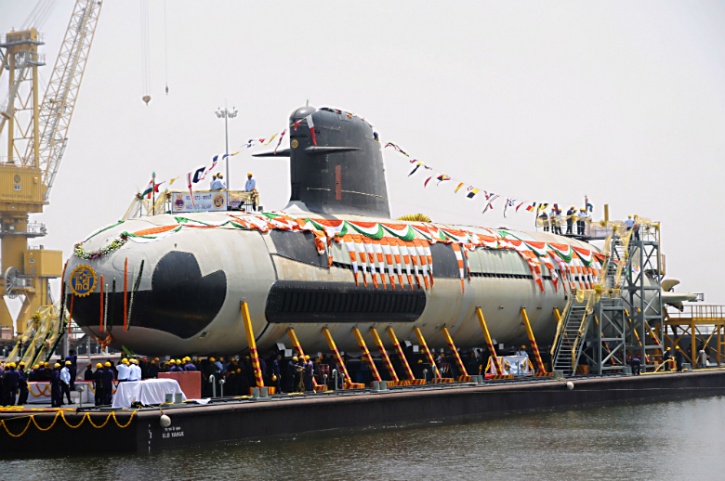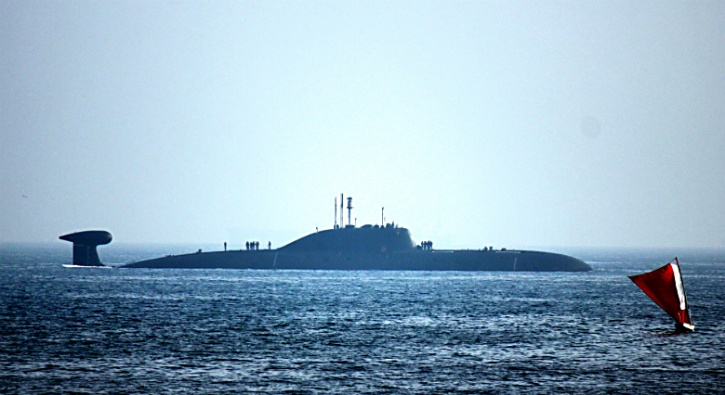"No first use" is politically and strategically useful, but if there was proof Pakistan was about to launch a first strike in 10 minutes I think India would try to preempt it. I've added the occasional comment in [ ] brackets and added bolded links. The string for Abhishek Saksena's article is http://www.indiatimes.com/lifestyle/technology/indian-navy-soon-to-be-the-most-formidable-submarine-force-on-the-planet-heres-what-you-need-to-know-232694.html :
"Indian Navy Soon To Be The Most Formidable Submarine Force On The Planet! Here's What You Need To Know"
"The most important thing about having nuclear weapons is a second strike capability. In a nuclear conflict, one who strikes first may win the war, but one who strikes second makes sure there is no one left to celebrate the win. That’s nuclear deterrence in a nutshell. While it sounds easy in theory, building a nuclear doctrine with a working second strike capability is anything but. India, for example, has declared a no-first-use of nuclear weapons. Which means, that though India will not initiate a nuclear conflict, if attacked it will retaliate with such ferocity, that it will wipe the enemy off the face of the map. How does India intend to do this? Like any other superpower, India wants to use submarines.
Submarines for projection of power

thehindu
If you think about it, submarines are the perfect weapons. Lurking in the depths of the oceans, they move around without being detected and surface to launch the attack on the unsuspecting enemy. Erstwhile superpowers USA and Russia continue to use their SSBNs (ballistic missile submarines) to great effect, projecting their might even today. These SSBNs ensure that even though the land-based missiles and airplanes may have been taken out, the enemy is guaranteed a sending off that it will never forget. And if India wants to be taken seriously on the world stage, it will have to start acting like a superpower, by being able to extend the country’s power across the globe. These submarines are therefore just what India needs.
Current state of submarine force
The current state of the Navy’s underwater fleet is, for lack of a better word, worrisome. India currently has 9 Sindhughosh class (Soviet Kilo class) and 4 Shishumar-class (German HDW Type 209) diesel electric subs and a single nuclear powered INS Chakra (Akula II class) sub. For a country with a coastline that measures more than 7,500 km, a fleet of 15 submarines is just not enough. And 15 isn’t the actual number of subs available for duty, because some of them are in ports for refits and maintenance. In comparison, China has a total of 67 submarines in its Navy. [In comparison Australia has a mainland coastline of 35,876 km and only 6 subs. How do you think we feel?]
Nuclear Submarine Program

hisutton.com
India started building its first nuclear submarine, the INS Arihant, under the highly secretive ATV program. In fact the project was such a secret, that it wasn’t until July 2009, when it was actually launched, that it was even officially acknowledged to exist. Work though had started back in the 80s, with Soviet help, to build a nuclear powered hunter-killer sub. India also leased a Charlie-I sub named the INS Chakra between 1987 and 1991 to gain experience in operating nuclear subs. The ATV though moved on from being an attack sub to a ballistic missile carrier as India conducted the second set of nuclear tests in Pokhran. The biggest challenge faced was in miniaturising the Pressurised Light Water Reactor which could fit in the tight confines of the sub’s hull. Based on a Russian design, a land-based version was built by BARC before the actual reactor, of a reported 83 MW capacity, was placed in the sub.
The INS Arihant, after launch in 2009, went through an extensive set of tests including harbour acceptance trials with the on-board reactor going critical in 2013. But it was only in December 2014 that it left the harbour for its sea trials. The Navy Chief, Admiral R K Dhowan, had recently stated that the sea trials of the sub are going “very well”, but refused to give a deadline for their completion.

wikimedia commons
According to reports, the Arihant should be commissioned by the end of this year, after which it can be put on active patrol duty. But before that can happen, it will have to integrate its primary weapon, the K-15 SLBM (Submarine Launched Ballistic Missile). The Arihant will carry up to 12 of these nuclear capable missiles with a range of 750 km. While this reach is quite low to hit deep inland targets from the middle of the seas, another missile, the K-4 with a range of 3,500 km is also in the works. In fact, a test of the K-4 has reportedly been carried out in secret. Beyond these, the K-5 missile, with a range of 5,000 km, is also being planned. The latter will likely be deployed with MIRVs (Multiple Independently Targetable Reentry Vehicle) which give each missile the ability to target up to four or more targets.
Although the INS Arihant can carry either 12 K-15s or 4 K-4s, the 3 boats which will follow, will be able to carry up to 8 K-4s or 24 K-15s. The next one will be christened INS Aridhaman. [I estimate Aridhaman may weigh 8,000-9,000 tons surfaced] And since the rest of the Arihant-class boats will be bigger than the lead boat, they are also expected to have a more powerful nuclear reactor. The crews for these missile carriers are gaining experience in operating nuclear boats on the Akula II class INS Chakra that India had leased in 2012 for ten years.
Future Nuclear Boats
But it doesn’t stop here. A follow-on class of 6 SSBNs codenamed S5, almost twice as big as the Arihant-class, was also approved for development. These will be able to carry up to 12 K5 intercontinental ballistic missiles with MIRV warheads. And SSBNs aren’t the only nuclear submarines that the Indian Navy will field. Early this year, the government cleared a project to build six new hunter killer boats (SSN) for the Navy. A joint Navy, BARC and DRDO project, the boats will be designed by Navy’s Directorate of Naval Design and be powered by a new reactor being developed by BARC. SSNs are as important as SSBNs as they can blockade important sea routes, denying the enemy access to important resources in an event of war, and shadow enemy ships. This new SSN will be similar in size to the Arihant-class but will carry advanced torpedoes and be able to move much quicker. Also, India is likely to lease another Akula II for 10 years in 2018, most likely the Kashalot that is 60% complete and in need of funds.
Conventional Submarines

Things are looking up for India’s conventional submarine fleet too. Under the Project-75, six French-Spanish Scorpene submarines are being constructed at Mazagon Dock Ltd. The first of these, named INS Kalvari [Scorpene], has recently been ‘undocked’ and will undergo sea trials next year and is expected to be commissioned into the Navy by September 2016. Incidentally, Indian Navy’s first ever submarine, which was a Soviet Foxtrot-class sub, was also called the INS Kalvari [Foxtrot]. The name Kalvari means Tiger Shark, and in naval tradition, the line of subs will be called the Kalvari-class. Although late by nearly four years, the Kalvari-class will add a punch to the dwindling underwater arm of the Navy. The nearly 1600-tonne subs have a complement of 31 men and can stay out to sea for 50 days. Its two diesel generation sets give it a submerged top speed of 20 knots (37 km/h). Its weapons suite includes Black Shark heavy weight torpedoes that can sink a ship 50 kms away and Exocet anti-ship missile [SM39] that travels a few feet from the surface of the sea and hits the hull of a target that’s 180 km away. It’s also one of the stealthiest diesel electric submarines in operation with emphasis on reducing hydrodynamic noise, which makes it invisible to enemy sonar. The last two boats of the class will also feature a DRDO designed Air Independent Propulsion (AIP) system which will give it longer endurance and make it stealthier because they won’t need to surface for air to charge the batteries.
Alongside the Kalvari-class will be six of the next generation P75(I) diesel electric submarines, all of which will be built in India. Apart from the ability to fire long range heavy weight wire guided torpedoes and an AIP system, this new line of subs can also feature land attack capability. For this, the submarines will have to integrate a Vertical Launching System in the hull. The VLS will allows subs (and surface ships) to carry the world’s fastest cruise missile, the Brahmos [BrahMos], with a range of 290 km and the under development Nirbhaya cruise missile which has a range of 1,000 km. The Brahmos has already demonstrated the underwater launch capability and Nirbhaya too is being designed for launch from multiple platforms. But it remains to be seen if this capability can be integrated into the boats that are likely in contention. DCNS is expected to offer the Scorpene, while Russia is pitching the Amur 1650 which is the export version of the Lada class, which itself is an advance variant of the Kilo-class already in service with the Indian Navy. Other contenders include the S-80 by Navantia of Spain and the German HDW Type 214. India has also asked Japan to participate in the competition with its Soryu-class subs.

So India is likely to field nearly 28 submarines including Arihant class subs, Follow-on SSBNs, New SSNs, 6 Kalvari class SSKs and 6 more P 75(I) boats, making it the most formidable submarine force in the Indian Ocean region." ENDS
---------------------------------
Also see Submarine
Matters articles:
- India's Unnamed Project for 6 SSNs Begins, May 29, 2015
- Pace of India’s nuclear submarine program, Arihant, Chakra, April 10, 2015
- Indian Possible Interest in Buying-Building Japan’s Soryu Submarine – Australia, January 30, 2015
- South Asian Submarine Issues, December 7, 2014, concerning construction of India's emerging SSBN base at INS Varsha on the East coast below Visakhapatnam.
- India’s Plans for 21 More Subs including SSNs, August 24, 2014
- Pace of India’s nuclear submarine program, Arihant, Chakra, April 10, 2015
- Indian Possible Interest in Buying-Building Japan’s Soryu Submarine – Australia, January 30, 2015
- South Asian Submarine Issues, December 7, 2014, concerning construction of India's emerging SSBN base at INS Varsha on the East coast below Visakhapatnam.
- India’s Plans for 21 More Subs including SSNs, August 24, 2014
Pete
Dear Pete,
ReplyDeletedid you followed the link about "DRDO developing [...]"?
There is a nice hint about the MESMA system: "The French MESMA AIP being offered for the Scorpenes is an old system with a steam turbine,” said V. Bhujanga Rao, DRDO director general (naval systems and materials). India will use hydrogen fuel cells instead.
Regards,
MHalblaub
Hi MHalblaub
ReplyDeleteThanks for spotting that.
Yes the "DRDO developing..." link which is http://www.thehindu.com/news/national/kerala/drdo-developing-onboard-equipment-monitoring-system-for-submarines/article5826308.ece is quite revealing. It indicates DRDO is talking to "French firm DCNS to install the DRDO-developed AIP based on hydrogen fuel cell on the last Scorpene submarine built at Mazagaon Dock under the Navy’s Project 75.'
This must be galling (or is that Gaul-ing) for the French because the world experts on "hydrogen fuel cell" AIP just happen to be the Germans. Germany's HDW 212s, forein customer 214s and Israeli Dolphin 2 subs use German fuel cell AIP.
As one can assume DRDO are talking to TKMS-HDW it may be an argument that India chooses the HDW-214 for the Project 75I selection.
Meanwhile, to my knowledge, French MESMA for France or foreign customers, has only consisted of three of Pak's Agosta subs - with no further MESMA orders. No wonder France is seeking to develop a "second generation AIP".
Regards
Pete
Peter,
ReplyDeleteCheck out this link for Indian Naval activities.
http://indiatoday.intoday.in/story/india-china-relations-modi-government-indian-ocean-naval-expansion/1/425929.html
Hi ZuluEcho
ReplyDeleteThanks for link http://indiatoday.intoday.in/story/india-china-relations-modi-government-indian-ocean-naval-expansion/1/425929.html
I intend to turn it into an article next week.
The writing style and likely database between the India Times and India Today articles seem quite similar. Is there some current-retired gifted officer in the Navy or Defence with a flair for submarine program writing?
A cautionary note. A regular problem in Australia is that writing on weapon's programs often promise rapid results. Decade long programs are envisaged to take only 5 years.
It is almost as if the weapon program writings are all politicians and the public need to deliver the funds. Actual building and sound completion of submarine programs is a match more difficult process. 10 years late for twice/thrice the money is quite possible.
Even India may suffer this.
Regards
Pete
No, India will not pre-empt in any scenario. NFU is a concious decision and India will abide by it.
ReplyDeleteHowever, you need to see this : https://twitter.com/rajfortyseven/status/599933237150879745
Please tell Abhishek also to have a look.
Hi RAJ47
ReplyDeleteWelcome back :)
https://twitter.com/rajfortyseven/status/599933237150879745 and https://twitter.com/rajfortyseven generally has many great photos and links on Chinese PLAN subs, ships and some Pak. Though I didn't see anything on Indian subs.
Regards
Pete
Dear Pete,
ReplyDeleteIndia wants a VLS for the Project 75. Therefore I suspect TKMS is also offering the Type 216 to India.
Regards,
MHalblaub
Hi MHalblaub
ReplyDeleteIt is a mark of military efficiency that one calls:
- the current 6 Scorpene "Project 75" and
- future 6 SSK undecided "Project 75I"
If India is wise it will save the high cost of VLS (or VMPL) for India's 2030s 6 SSN project.
India should not make Australia's mistake of buying large orphan SSKs for mounting VLS.
How about Indian Dolphin 2s that can fire torpedo tube launched 1,200km SLBM/SLCMs like Israel.
Regards
Pete
Dear Pete,
ReplyDeleteI guess the necessity for a vertical launch system is the same as for the excessive range for Collins-class or its replacement: prestige.
The US and the Soviet Union/Russia have VLS so China and India also need big subs with a VLS. Also the http://en.wikipedia.org/wiki/Sagarika_(missile) could be just to big.
India tried the Soviet Kilo, German Type 209 and now French Scorpene but also the INS Arihant. Maybe an Indian SSN is not so cheap and India wants a not so expensive solution to launch some big nukes. Maybe it is wise to save the high cost for SSNs.
Regards,
MHalblaub
Hi MHalblaub
ReplyDeleteYes I think very large, probably orphan, SSKs mounting VLS is illogical when one could probably buy off-the-shelf SSNs/SSGNs more cheaply.
Australia's admirals refuse to look at Israel's Dolphin 2 which has horizontal solutions for "Popeye Turbo" missiles, LDUUV and diver assist. Dolphin 2s tubes are regular 533mm but also some 650mm.
Australia should really be shopping for a Dolphin 2AU which could fire Tomahawks out of the 533s and LDUUV + divers out of 650mm
Indeed Sagarika K-15s are too big at 740mm diameter.
India might do better to start with cheaper, smaller (2,500 ton) http://en.wikipedia.org/wiki/Rubis-class_submarine SSNs. I'm sure the French have offered the indigenous design option or Made in France.
Regards
Pete
India will have 40 submarines in its naval fleet by 2030...the fleet will follow like this..
ReplyDelete4 Arihant Class SSBNs
6 follow-on Avinash Class SSBN
6 new SSNs
1 Akula SSN on lease
9 Scorpean Class SSKs
6 Project-75I SSKs
4 Upgraded Sindhughos (Kilo) Class SSKs
3 New Kilo Class SSKs
2 Upgraded HDW class SSKs
Hi Abhishek Das
ReplyDeleteYes over the next 24 years (to the late 2030s) India May have all those. But the biggest question marks are:
1. will India have all 10 SSBNs? all armed with Trident like K-4s?
10 is more than the UK, France and China each have now. So will India then be in competition with the US and Russia?
2. Might not just 6 SSBNs all up be likely? https://en.wikipedia.org/wiki/Future_of_the_Indian_Navy#Submarines
3. Would Indian SSNs be ready? Even though there is no developed 3rd generation sub reactors?
4. Surely all of India's HDW https://en.wikipedia.org/wiki/Shishumar-class_submarine would be retired before th late 2030s. By 2030 they would be around 34 years old.
Regards
Pete